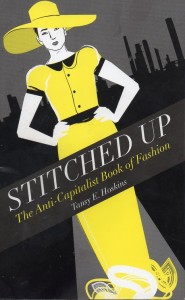Book Review: Stitched Up: The Anti-Capitalist Book of Fashion by Tansy E Hoskins
Disclaimer: I received this book through a Goodreads giveaway on the premise that I would review it.
Fashion…isn’t something I notice a lot. I buy clothes when I have to, and try to wear matching socks, but I don’t know a lot about fashion as a subject. This book may or may not have helped with that.
Early on, Ms. Hoskins defines fashion as “changing styles of dress and appearance adopted by groups of people” so that she can talk about the entire clothing and accessories industry, as opposed to just haute couture. She chooses to view the industry through an “anti-capitalist” lens, which yes, does take its roots from Marxism.
The book primarily deals with the modern fashion industry, from the Industrial Revolution on, and doesn’t dwell too much on the early history. The first few chapters provide an overview of the industry, from the wealthy owners through the fashion press to the exploited factory workers. It should be noted here that this is a British book, and this influences the examples given.
Then there is a section about the many problematic issues involving fashion, such as environmental damage, body image and racism. (The recent film biography of Coco Chanel cut off before World War Two for a reason.) There’s a fair bit in here that I already knew, but I had no idea of just how bad it actually was.
The final chapters of the book deal with ways in which people are resisting, and trying to reform fashion, but Ms. Hoskins believes that all the problems with the fashion industry are at their roots caused by capitalism. Therefore, revolution to smash capitalism is the only true solution.
The last chapter goes into some detail of what post-capitalist fashion might involve. The author points out the (sadly short-lived) blossoming of the arts and textile design in the post-revolution Soviet Union. However, the cautionary tale of Cultural Revolution China is also mentioned, where a simple outlawing of “reactionary” fashion led to nationwide conformity because the Mao suit was the only thing everyone could agree was not reactionary, and therefore safe to wear.
Ms. Hoskins is thinking that revolution should instead lead to more of a democratic socialism…or something. Anyway, smash capitalism, and everything else should work out okay.
The striking illustrations are by Jade Pilgrom. There are extensive end notes, a bibliography and index.
I’d recommend this book to students of fashion, budding Socialists and people who have always wondered what the big deal is with fashion, anyway.

